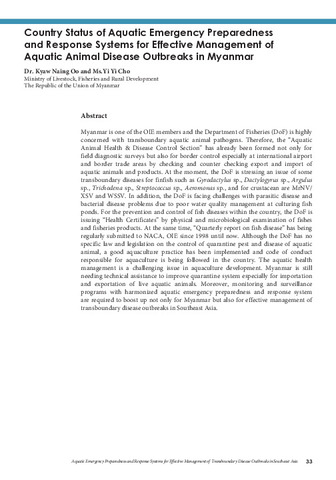Development of immunostimulant for mud crab, Scylla serrata
- Global styles
- MLA
- Vancouver
- Elsevier - Harvard
- APA
- Help

Date
2017Author
Page views
2,483ASFA keyword
AGROVOC keyword
Taxonomic term
Metadata
Show full item record
Share
Abstract
Non-specific immune activitation is considered a potential prophylactic approach in the prevention of disease outbreaks in crustacean aquaculture. The present investigation evaluates the dietary supplementation of bacterial and algal derived immunostimulants including peptidoglycan, ergosan, mannan oligosaccharide and acidic polysaccharides from Ulva, Sargassum and Padina to enhance the immunological responses and resistance of Scylla serrata juveniles against white spot syndrome virus (WSSV) infection. Each of the test immunostimulant was optimized for dose and frequency of administration.
Results showed significant enhancement of shrimp survival against WSSV infection if Mannan oligosaccharide is supplemented at 2000 mg kg-1 diet applied every 3 days. Optimum dose and frequency of application for peptidoglycan was determined as 1000 mg kg-1 diet applied every 3 days while a dose of 2000 mg kg-1 diet applied every 3 days was found optimum for ergosan. Enhancement of survival was also observed in crabs given the acidic polysaccharide extracts from seaweeds. Better survival was observed in the treatment receiving Ulva at 1000 mg kg-1 applied every 3 days. Similar dose and frequency were also observed to enhance the resistance of the juvenile crabs against WSSV when maintained with diets supplemented with Padina and Sargassum acidic polysaccharides. The high survival in these treatments is associated with the prominent enhancement of immunological responses including phenol oxidase activity, respiratory burst and total hemocyte counts. At optimum dosage and application frequency, these immunostimulants are observed to improve overall growth performance of the juvenile crab. These results suggest that dietary supplementation of peptidoglycan, ergosan mannan oligosaccharide, and acidic polysaccharides from Ulva, Sargassum and Padina at a dose described above can be used to boost the immunological response and enhance the resistance of S. serrata juveniles against WSSV infection.
Description
Abstract only.
Suggested Citation
Traifalgar, R. F. (2017). Development of immunostimulant for mud crab, Scylla serrata. In E. T. Quinitio, F. D. Parado-Estepa, & R. M. Coloso (Eds.), Philippines : In the forefront of the mud crab industry development : proceedings of the 1st National Mud Crab Congress, 16-18 November 2015, Iloilo City, Philippines (p. 155). Tigbauan, Iloilo, Philippines: Aquaculture Department, Southeast Asian Fisheries Development Center.
Type
Conference paperISBN
9789719931072Collections
Related items
Showing items related by title, author, creator and subject.
-
Health management in aquaculture
Lio-Po, Gilda D.; Lavilla, Celia R.; Cruz-Lacierda, Erlinda R. (Aquaculture Department, Southeast Asian Fisheries Development Center, 2001)A textbook on diseases of cultured warmwater fish and shrimps in the Philippines. Eleven chapters cover essential information on the basic principles of disease causation, major diseases of cultured fish and crustaceans, ... -
Health management in aquaculture
Lio-Po, Gilda D.; Inui, Yasuo (Aquaculture Department, Southeast Asian Fisheries Development Center, 2010-07)A textbook on diseases of cultured warmwater fish and shrimps in the Philippines. Eleven chapters cover essential information on the basic principles of disease causation, major diseases of cultured fish and crustaceans, ... -
Country status of aquatic emergency preparedness and response systems for effective management of aquatic animal disease outbreaks in Myanmar
Oo, Kyaw Naing; Cho, Yi Yi (Aquaculture Department, Southeast Asian Fisheries Development Center, 2019)Myanmar is one of the OIE members and the Department of Fisheries (DoF) is highly concerned with transboundary aquatic animal pathogens. Therefore, the Aquatic Animal Health & Disease Control Section has already been ...






